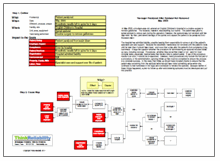The team investigating medical errors that happened at a Washington hospital has an unusual member: the man who was paralyzed as a result of these medical mistakes. Not only does he want to know what happened, he hopes that his design experience (he formerly designed for Microsoft) can be translated to healthcare to “make hospitals everywhere safer for patients.”

The second step of the process, the analysis, develops cause-and-effect relationships beginning with one of the impacted goals. In this case, the patient safety goal was impacted due to the paralysis of a patient. The paralysis resulted from a spinal cord injury, which was caused by a significant back fracture. There are times when more than one cause is required to produce an effect. The significant back fracture was caused by an untreated hairline fracture on the back AND the patient being moved inappropriately. If either of these things had not occurred, the outcome may have been very different. The analysis continues by asking ‘why’ questions of both the causes.
The patient had a hairline fracture on his back that resulted from a fall out of bed (due to “luxurious sheets”) and a condition (ankylosing spondylitis), which makes the spine brittle and more prone to fractures. Beginning on May 12, 2013, the patient visited the hospital’s emergency room four times in two weeks. The hairline fracture was untreated because it was not diagnosed during any of those visits, despite the patient’s insistence that, because of his condition, he was concerned about the possibility of a back fracture. While the hairline fracture is visible on the imaging scan, according to the patient’s lawyers, it was missed because the scan was focused on the abdomen. The notes from the first doctor’s visit were not documented until 5 days after the encounter.
On May 25, 2013, two weeks after the initial injury, the patient returned to the emergency room for severe pain and an MRI was ordered. While being positioned in the MRI, the patient lost neurological function from about the neck down. He was transferred to another hospital, who found it likely that the paralysis had resulted from being positioned in the MRI.
The patient was inappropriately moved, given his injury (which at this point was still undiagnosed and untreated). The patient was being positioned for an MRI ordered to find the cause of his back pain (probably due to the untreated hairline fracture of his back). Either the previous imaging scan was not reviewed by the doctors at this visit, or the scan was unavailable. Had the imaging scan indicating a hairline fracture been available, the MRI may not have been necessary. If the patient was given an MRI anyway, the staff would have been aware of the fracture and would likely have moved the patient more carefully.
However, the staff was not aware of the injury. The patient’s repeated concern over having a back fracture was unheeded during all his visits, and the staff appeared to be unaware of the medical information from the three previous visits, likely due to ineffective communication between providers (a common issue in medical errors).
As more detail regarding the case is discovered, it can be added to the Cause Map. Once all the information related to the case is captured, solutions that would reduce the risk of the problem recurring can be developed and those that are most effective can be implemented. The patient will be a part of this entire process.
To view the initial Cause Map of this issue, click on “Download PDF” above. Or click here to read more.

